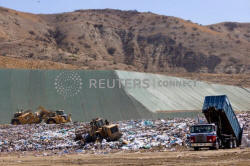Methane menace: Aerial survey spots 'super-emitter' landfills
 Send a link to a friend
Send a link to a friend
 [June 18, 2021] By
Nichola Groom [June 18, 2021] By
Nichola Groom
LOS ANGELES (Reuters) - The U.S.
waste-management industry has become a darling of environmentally minded
investors for its work in recycling trash and harvesting gases from
landfills as an alternative fuel.
Leading firms Waste Management Inc and Republic Services Inc are
included in the Dow Jones Sustainability World Index, a benchmark for
socially conscious investing. The firms' major investors include funds
controlled by billionaire philanthropist Bill Gates and
wealth-management icon Larry Fink, founder of BlackRock Inc, who are
both leading advocates for corporate climate action.
But the waste industry may be doing far more harm to the planet than
investors think, according to a years-long aerial survey commissioned by
California air-quality regulators. The survey found "super-emitter"
landfills accounted for 43% the measured emissions of the potent
greenhouse gas methane - outpacing the fossil-fuel and agricultural
sectors.

NASA's Jet Propulsion Laboratory in Pasadena and leak-detection firm
Scientific Aviation have been conducting the flyovers since 2016. They
found that some trash dumps operated by top U.S. landfill companies
including Republic Services and Waste Management have been leaking
methane at rates as much as six times the facility-level estimates from
the U.S. Environmental Protection Agency (EPA). (See graphic https://tmsnrt.rs/3vuZrAV
on California's "super-emitter" landfills).
The ten biggest methane-emitting landfills pumped out the gas at rates
averaging 2.27 times the federal estimates, which are produced by waste
firms using EPA methodology.
The California research may have wide-ranging global implications by
showing the waste-management industry is playing a bigger role in
accelerating climate change than regulators had believed. The surveys
could also reveal flaws with United Nations guidelines for estimating
methane emissions that are followed by the major governments including
the United States, according to scientists involved in the surveys and
regulators interviewed by Reuters.
The research could also bring scrutiny on the waste management industry
from both policy-makers and green investors - who until now have been
focused mainly on reducing greenhouse-gas emissions from fossil fuels,
said Eliot Caroom, a researcher at TruValue Labs, which provides
investors with environmental and social-governance data and analysis.
“One of the largest emitting industries, waste management, deserves more
attention,” he said.
Gates - who earlier this year published a book titled, How to Avoid a
Climate Disaster - owns more than a third of Republic Services. He owns
about 8% of Waste Management through stakes held by the Bill & Melinda
Gates Foundation Trust and his personal investment vehicle Cascade
Investment LLC, according to fund disclosures. BlackRock owns a 4.6%
share of Republic Services and 5% of Waste Management, mainly through
funds that track third-party indexes.
Officials representing Gates and BlackRock did not comment for this
story.
Inclusion in the Dow Jones sustainability indices is based on S&P Global
scores for a number of environmental, social and governance criteria.
Waste Management has the highest environmental score in the broader
commercial services sector and a near-perfect score for climate change
strategy. Republic Services also earned high marks for climate strategy.
Officials for Republic Services and Waste Management said they were
cooperating with the California flyover surveys.
Waste Management said it was expanding efforts to reduce methane leaks,
including better monitoring, adding more soil to cover landfills and
capturing the gas for reuse.
Republic Services said in a statement that the aerial survey data
represents snapshot data that may not accurately capture routine
emissions at its facility. It called itself a leader in responsible
landfill management.
FLAWED ASSUMPTIONS
Methane traps much more heat in the atmosphere than carbon dioxide,
although for a shorter period of time. All told, one tonne of methane
does about 25 times more damage to the climate over a 100-year period
than one tonne of carbon dioxide, according to the EPA.
[to top of second column] |

Workers use heavy machinery to move trash and waste at the Frank R.
Bowerman landfill on Irvine, California, U.S., June 15, 2021.Picture
taken June 15, 2021. REUTERS/Mike Blake

Methane concentrations in the atmosphere have been rising rapidly in recent
years, alarming world governments seeking to cap global warming under the 2015
Paris Agreement on climate change. Measuring those concentrations in the
atmosphere is relatively easy, but tracking the sources of the emissions is
hard. That difficulty has become a major stumbling block for global
policy-makers hoping to curb the problem.
The United Nations' International Panel on Climate Change (IPCC) issued
guidelines for governments in 2006 on how to estimate methane emissions from
landfills without direct measurements such as aerial surveys. Instead, the U.N.
has said, methane at landfills can be estimated using factors such as the amount
and content of waste stored on site and assumed rates of waste decay. Such
methods "really don't do the job anymore," said Jean Bogner, a University of
Illinois researcher who has studied methane emissions in landfills since the
1970s.
The IPCC said it would revisit its guidelines if U.N. member nations askedit to
do so.
The U.N. estimates that landfills and wastewater produce about a fifth of the
world’s human-caused methane emissions, behind only agriculture and the
oil-and-gas industry.
Landfills produce methane when organic materials like food and vegetation are
buried within them, rotting in low-oxygen conditions. The gas can leak out if
the soil covering the dump is too thin, for instance, or if pipes intended to
capture methane are broken.
About one-fifth of trash in the United States is food, according to the EPA, a
major driver of the problem. Methane emissions from landfills are less of a
problem in many developing nations, which tend to waste less food and use
open-air dumps rather than covering trash with soil, according to the IPCC.

UNDER THE RADAR
On February 26, an airplane flown by Scientific Aviation buzzed about 1,500 feet
above the Republic Services’ Forward landfill in Manteca in the Central Valley
and snapped a series of pictures using an infrared spectrometer.
Scientists said the image showed the trash dump was emitting more than a quarter
tonne of methane into the atmosphere each hour, the climate equivalent of nearly
12,000 cars idling on the nearby freeways. That rate is about six-times higher
than the EPA had estimated for the facility.
Previous fly-overs of the facility since 2017 had shown similar readings.
The California Air Resources Board (CARB), which commissioned the survey, hopes
the effort to find leaks will eventually help to curb emissions. A month after
the February flyover, state inspectors accompanied officials from the San
Joaquin Valley Unified Air Pollution Control District on a trip to examine the
Forward landfill. The group discovered methane leaks that exceeded allowed
limits in various locations, issuing two notices of violation to the landfill's
operator, according to an inspection report seen by Reuters.
In the most recent series of overflights which began last fall, regulators asked
landfill operators to use information relayed to them in real-time from the
aerial surveyors to find and fix leaks on the ground. The state is planning to
issue a report on the effort later this year.
Many of the leaks are easily fixed by adding more soil or fixing broken pipes
meant to capture methane for use as a fuel, said Jorn Herner, head of CARB's
research planning, administration and emissions mitigation.
The Biden administration last month announced it would require more U.S.
landfills to install gas-capture systems to help limit methane emissions. A
White House official did not comment for this story.
The state hopes to eventually replace the planes with space satellites.
California in April announced a $100 million project, backed by billionaire
Michael Bloomberg, to launch satellites in 2023 that will pinpoint large
emissions of greenhouse gases from landfills and other sources, such as
refineries, pipelines and farms.
(Reporting by Nichola Groom; editing by Richard Valdmanis and Brian Thevenot)
[© 2021 Thomson Reuters. All rights
reserved.] Copyright 2021 Reuters. All rights reserved. This material may not be published,
broadcast, rewritten or redistributed.
Thompson Reuters is solely responsible for this content. |